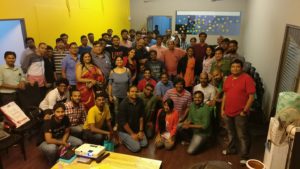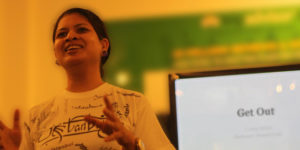How Ansoo Gupta Travelled to 70 Countries & Became a Role Model for Responsible Tourism
A Mumbai-based media professional and serial traveller, Ansoo is on a quest to see the world in the most sustainable way possible.
Ansoo Gupta recalls two of her earliest trips that awakened her wanderlust — a 1996 trip to McLeodganj and a trip to Australia’s Great Barrier Reef in Australia in 2002.
“What got me started was plain old ‘curiosity’. That inexplicable itch to actually see what you have only read about or seen in the books and websites,” says the Mumbai resident who has emerged as a popular influencer for countless aspiring travellers in India.
Having travelled to 70 countries in the last 15 years, Ansoo now promotes the cause of sustainable travel with her initiative One Shoe Trust.

For Ansoo, travelling is a means of reaching out to the world and finding one’s place in it. “There are always things that you don’t know, this unending quest, meeting new people who live differently than you, eat stuff that is so different from what we eat daily, see new sights and experience different cultures,” she says. “Just like no two people see the same rainbow, travelling makes you appreciate that each place, each person is a world in its own.”
She may be known for her travels, but Ansoo balances her itineraries expertly with her multiple commitments. She has worked at companies like National Geographic and Star TV and is now the COO of Pinstorm, a digital advertising firm. She is mother to two kids and runs a #neighbourhoodproject, photographing and documenting heritage sites in her city.
She runs the household, indulges in kitchen gardening, eats, exercises and claims with a laugh that the most critical activity in her day is sleeping. She says, “My trick is to not try to balance everything all the times. All these balls that I have to juggle, I let one or two drop once in a while, when I can’t balance all. I focus on what’s most important to look at, at that time.”
Amidst her numerous commitments, travel has remained a perennial favourite and a source of enriching life with stories.
She remembers almost all her travels, from watching thousands of floating lanterns in the sky accompanied by Buddhist chants in the background in Thailand to watching the Northern Lights in -35 deg centigrade at Abisko, Sweden. Her dearest experience? A four-month backpacking, bootstrapping trip across Europe.
Japan, Moscow, Jordan, Egypt have been some of her most special trips, and Ansoo finds joy even in itineraries gone awry. “Some mishaps like a flight unexpectedly landing in Togo or a plane malfunction mid-air in Myanmar are all memorable experiences – even if they were mildly annoying at that time,” she says.
Ansoo rues that excessive information has taken some of the charm of new discoveries out of travel. “It is tough to not know, difficult to get lost. And if you can’t get lost, you can’t stumble upon new, never-imagined places,” she says. The pressure of checking out must-see destinations also makes everyone want to do the same thing. Another of her pet peeves—“the whole ‘beauty-industrification’ of travel content”.
She says, “There seems to be a deluge of pretty pictures and adjectives in 80% of the travel content written today. Where are the personal adventure stories? Where are the funny twists that Bill Bryson found wherever he went? Where is the tragedy and shock that you feel seeing big garbage patches in the ocean in Hawaii? At a time when we need to wake up to problems that need to be fixed, travel writers still paint a rosy picture without devoting any column inches to reality. Travel is about seeing reality firsthand, not escaping into fantasy. If it is not pretty, let’s say it is not pretty.”
Ansoo envisions travel as a means of education, not as a status symbol. Yearning to shatter the cliched perception of travelling now, she decided to start initiatives that showcase the sensitive, sustainable side of travel.
She started her initiative with Come Plan Go, travel sessions that focus on how to travel with less. Less money, less time and less baggage—real and emotional.

She says, “I get mails and messages from people who attended my workshops telling me how they finally made their dream trip happen, how they could score a great airfare deal or how they finally took courage to travel solo. That is very satisfying for me. The session provides inspiration as well as equips people with travel hacks to convert their travel dreams to reality.”
Travel boosts local economies and offers unparalled life experiences, but its environmental strain has been tremendous. In Ansoo’s opinion however, one doesn’t need to put a stop to travelling but rather travel responsibly. She says, “Travellers enjoy natural sights and are generally more connected to Earth, so it’s up to us to take the first steps in protecting the planet.”
With this view in mind, she now uses her workshops and events to focus on responsible tourism and ensuring that travelling doesn’t lead to ecological crises. Her next event in Mumbai will bring together four experts, including herself, to speak about various aspects of sustainable living and travel.
Recent news reports suggest that the Great Barrier Reef, which marked the start of Ansoo’s journey, is damaged to an irreversible extent. Clearly, the need for responsible tourism is more than ever. A UNWTO report predicts that by 2020, there will be 50 million Indian tourists and for Ansoo, this can be harnessed for change.
She says, “If these tourists travelled responsibly, with an aim to understand local cultures and broaden their horizons, it can become a powerful resource to bring about the much-needed change in the way tourists are perceived and possibly start reversing some of the ecological damage that tourism causes as well.”
Ansoo’s tips for travelling responsibly

- Don’t buy bottled water, refuse plastic straw, and don’t use or accept plastic bags. Our earth and oceans are filling up with trillions of tonnes of garbage. Small items like water bottles, drinking straws and bags are the biggest culprits.
- Support local businesses. The real advantage of tourism economy is when the beneficiaries are local businesses and not multinational chains. We must take extra effort to identify and support locals.
- Don’t encourage child-labour, animal captivity etc. Avoid animal rides and places like the Tiger Temple (Thailand) which thrive on keeping animals in bad conditions to make a quick buck.
- Travel to off-beat places. Diffusing pressure from ‘top 10’ places to go to is the need of the hour. Not only will you get a more authentic experience, it also saves concentration at fewer places.
- Travel Light. This is not just for modesty but has far-reaching impact in terms of choice of transport too. Minimalism is totally on-trend and we must get rid of extra stuff from our lives, especially while travelling.
- Understand and respect local cultures. There should be only one reason for your travel – to satisfy your curiosity. If that is the aim, you will always try to understand the local culture rather than spending a good time in hotels and beaches.
Check out Ansoo’s page on Facebook. To contact the One Shoe Trust team, click here.
Interviewed by : The Better Indian
How Ansoo Gupta Travelled to 70 Countries & Became a Role Model for Responsible Tourism





